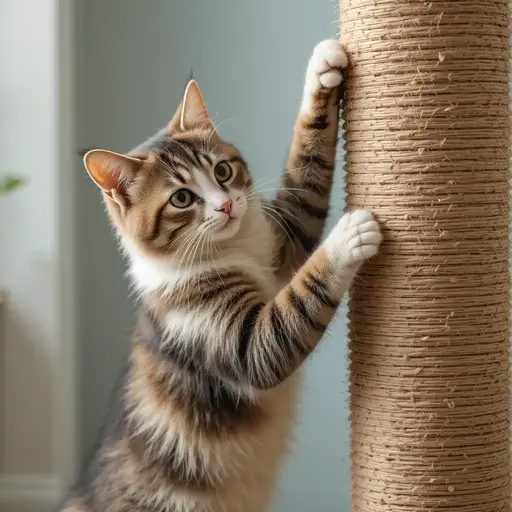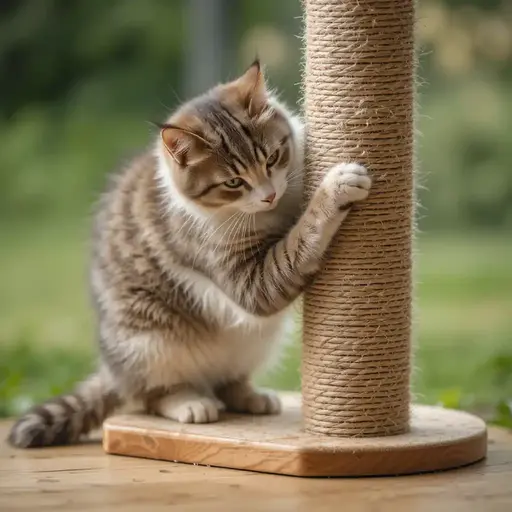Cat Breeds That Don’t Scratch Furniture are those with calm temperaments and a naturally low urge to damage upholstery, such as Ragdolls, British Shorthairs, and Persians. While no cat is truly “scratch‑proof,” choosing these breeds and giving them proper outlets can dramatically cut furniture wear.
If you’re dreaming of a snag‑free sofa, read on to discover the science behind scratching, the ten best breeds, training tips, and the perfect post for your feline friend.
Why Understanding Cat Scratching Matters
Scratching is a built‑in feline instinct: it trims claw sheaths, marks territory with scent glands, and stretches muscles. When this natural behavior meets a plush couch, owners often feel frustrated and worried about costly repairs.
Recognizing the why behind scratching helps you address the root cause rather than merely covering up the symptoms.
- Claw health – Regular scratching removes the dull outer layer of a cat’s nails.
- Territory signaling – Paw pads release pheromones that tell other cats, “this is my space.”
- Stress relief – The act releases endorphins, calming an anxious cat.
By providing appropriate outlets, you protect both your furniture and your cat’s well‑being.

How to Choose Cat Breeds That Don’t Scratch Furniture
Not all cats are created equal when it comes to furniture‑friendly habits. Breed temperament, energy level, and intelligence influence how quickly a cat adopts a scratching post instead of a couch.
- Calm temperament – Breeds that stay relaxed tend to scratch less out of boredom.
- Low to moderate energy – Cats that don’t need constant high‑intensity play are easier to redirect.
- Trainability – Intelligent, reward‑responsive cats learn appropriate scratching faster.
When you match a breed’s natural tendencies with your lifestyle, you set the stage for a harmonious home.
Top 10 Cat Breeds That Don’t Scratch Furniture
Below is the definitive list of the most furniture‑friendly cats. Each breed’s profile includes temperament, typical scratching behavior, and tips for keeping your home scratch‑free.
| Rank | Breed | Typical Temperament | Scratching Tendencies | Ideal Scratching Solutions |
|---|---|---|---|---|
| 1 | British Shorthair | Laid‑back, independent | Low – prefers lounging | Sturdy vertical sisal post near favorite resting spot |
| 2 | Ragdoll | Docile, “puppy‑like” | Very low – loves to be held | Wide horizontal pad beside the sofa |
| 3 | Persian | Quiet, low‑energy | Minimal – enjoys grooming | Low‑profile carpeted scratcher near sunny windows |
| 4 | Scottish Fold | Adaptable, affectionate | Low when trained early | Dual‑style post (vertical + horizontal) |
| 5 | Maine Coon | Gentle giant, curious | Moderate – likes tall surfaces | Tall sisal trunk with a perch on top |
| 6 | Siamese | Vocal, intelligent | Moderate – needs mental stimulation | Interactive climbing tower with scratching wraps |
| 7 | Sphynx | Energetic, skin‑sensitive | Low – prefers rubbing | Soft fabric pad with catnip sprinkle |
| 8 | Russian Blue | Reserved, graceful | Low – calm demeanor | Narrow vertical post placed near a quiet corner |
| 9 | American Shorthair | Easygoing, adaptable | Low to moderate | Horizontal cardboard scratcher paired with toys |
| 10 | Norwegian Forest Cat | Independent, loves heights | Moderate – seeks tall structures | Sturdy log‑style post with natural bark texture |
1. British Shorthair – Calm and Low‑Maintenance
Why it’s furniture‑friendly: This breed’s steady, low‑energy nature means it rarely seeks an outlet for excess activity.
- Key traits: Rounded face, plush coat, stoic demeanor.
- Scratching tip: Place a sturdy sisal post near the favorite chair; the cat will quickly claim it as its own.
2. Ragdoll – Docile and Affectionate
Why it’s furniture‑friendly: Ragdolls prefer to be cradled rather than climb, making them natural couch companions without destructive claws.
- Key traits: Blue eyes, silky semi-long hair, “floppy” when held.
- Scratching tip: Offer a wide, low horizontal pad; reward with treats when used.
3. Persian – Quiet and Less Active
Why it’s furniture‑friendly: Persians spend most of their day grooming, so they have little drive to scratch aggressively.
- Key traits: Flat face, luxurious coat, calm disposition.
- Scratching tip: Provide a soft carpeted scratcher; keep nails trimmed weekly.
4. Scottish Fold – Trainable and Adaptable
Why it’s furniture‑friendly: Their folded ears hint at a mellow personality, and they respond well to positive reinforcement.
- Key traits: Rounded ears, round eyes, easygoing.
- Scratching tip: Use a dual‑style post; reward with a clicker and treat when the cat uses the vertical side.
5. Maine Coon – Gentle Giants
Why it’s furniture‑friendly: Although large, Maine Coons are gentle and love sturdy, tall scratching structures.
- Key traits: Bushy tail, tufted ears, friendly.
- Scratching tip: A tall sisal trunk with a perch satisfies their love of height and keeps sofas safe.
6. Siamese – Intelligent and Trainable
Why it’s furniture‑friendly: Their high intelligence makes them quick learners, especially when training is fun.
- Key traits: Almond eyes, sleek body, vocal.
- Scratching tip: Combine a climbing tower with hidden toys; praise every successful use.
7. Sphynx – Hairless and Less Destructive
Why it’s furniture‑friendly: Lacking fur, they often prefer soft surfaces to scratch and focus on warmth.
- Key traits: Wrinkled skin, large ears, playful.
- Scratching tip: Offer a soft fabric pad; a dab of catnip will entice them to use it.
8. Russian Blue – Quiet and Undemanding
Why it’s furniture‑friendly: Their reserved nature means they rarely act out, and they enjoy calm environments.
- Key traits: Silvery coat, emerald eyes, shy at first.
- Scratching tip: Place a narrow vertical post in a quiet corner; reinforce with occasional treats.
9. American Shorthair – Easygoing and Adaptable
Why it’s furniture‑friendly: This breed’s adaptability lets them thrive in apartments with modest enrichment.
- Key traits: Classic tabby patterns, friendly, low maintenance.
- Scratching tip: Provide a horizontal cardboard scratcher near the favorite window perch.
10. Norwegian Forest Cat – Independent but Gentle
Why it’s furniture‑friendly: Their natural love for high places means they prefer logs or tall posts over sofas.
- Key traits: Thick double coat, lynx‑like ear tufts, adventurous.
- Scratching tip: Offer a log‑style post wrapped in natural bark; add a hanging toy for extra allure.

Training and Enrichment Tips to Keep Any Cat From Scratching Furniture
Even the calmest cat breeds that don’t scratch furniture benefit from proper training and environmental enrichment. Follow these evidence‑based steps to channel scratching into safe zones.
- Introduce the right scratching post early.
- Place the post next to the piece of furniture the cat currently targets.
- Use a feather wand or laser pointer to lure the cat onto the post.
- Reward every successful scratch.
- Offer a small treat or a burst of praise immediately after the cat uses the post.
- Consistency builds a positive association that outweighs the lure of the sofa.
- Make the furniture unappealing
- Apply double‑sided tape or a plastic scratch guard on the arms of chairs.
- Cats dislike the sticky surface, so they look for a smoother alternative.
- Add pheromone diffusers
- Feliway or similar synthetic feline facial pheromones reduce anxiety‑driven scratching.
- Plug one near the main scratching area and replace every 30 days.
- Rotate toys and climbing structures
- A bored cat may turn to the couch for entertainment.
- Keep a small selection of interactive toys (e.g., puzzle feeders) on rotation to maintain novelty.
- Trim nails regularly
- Weekly trims keep claws short enough to minimize damage but long enough for the cat to maintain natural wear.
- Use a cat‑specific nail file or guillotine clipper for safety.
- Consider soft nail caps
- Vinyl caps slide over the claws and dull the impact on upholstery.
- Apply them after a calm grooming session; replace every 4–6 weeks.
By following these steps, you’ll find that even active breeds quickly learn to respect your furniture, reinforcing the idea that cat breeds that don’t scratch furniture can thrive anywhere with proper guidance.

Choosing the Right Scratching Post for Your Cat
A well‑chosen scratching post is the cornerstone of a scratch‑free home. Below are the key factors to consider.
Types of Scratching Posts
- Vertical posts – Ideal for full‑body stretches; simulate a tree trunk.
- Horizontal pads – Preferred by cats that love to “paw” at ground surfaces.
- Combo towers – Offer both vertical and horizontal surfaces, perfect for versatile breeds like the Siamese or Maine Coon.
Selection Criteria
| Factor | What to Look For | Why It Matters |
|---|---|---|
| Height | At least as tall as the cat’s outstretched front legs | Allows a full stretch without the cat feeling cramped. |
| Stability | Heavy base or wall‑mounting options | Prevents wobbling, which can discourage use. |
| Material | Sisal rope, carpet, or corrugated cardboard | Each mimics natural textures cats love; sisal is the most durable. |
| Location | Near favorite sleeping spots or the furniture the cat currently scratches | Increases visibility and convenience, encouraging adoption. |
DIY Scratching Post Ideas
- Sisal‑Wrapped Log – Secure sisal rope around a sturdy wooden log using non‑toxic glue; add a weighted base.
- Cardboard Box Tower – Layer several corrugated boxes, cut entry holes, and tape them together; sprinkle catnip for extra appeal.
- PVC Pipe Scratcher – Join PVC pipe sections vertically, wrap in carpet or sisal, and attach to a heavy base.
Pro tip: After placing a new post, rub catnip on it and immediately reward the cat for using it. This accelerates the habit formation process.
Common Myths About Cat Scratching Debunked
| Myth | Reality |
|---|---|
| Only certain breeds scratch | Every cat scratches; breed influences how often and where, not whether. |
| Declawing solves the problem | Declawing removes a vital defense tool, leads to pain, and does not stop the urge to scratch. |
| Declawing solves the problem. | Scratching fulfills essential physiological needs: claw maintenance, scent marking, and stress relief. |
| Pheromone sprays replace training. | Even low‑energy breeds require vertical space and mental stimulation to stay content. |
| Cats scratch only for fun. | Sprays can reduce anxiety but won’t teach a cat where to scratch; they work best alongside rewards. |
Understanding these facts helps you apply practical solutions rather than relying on misconceptions.

FAQs
Will switching to a different breed stop my cat from scratching?
Changing breeds can reduce the frequency of destructive scratching because some cats have calmer temperaments. However, all cats have the instinct to scratch; proper training and enrichment are still essential.
How many times a day should my cat use a scratching post?
Most cats scratch 2–4 times daily, often after waking, feeding, or a nap. Providing multiple posts encourages the habit and spreads use across the house.
** Are soft nail caps safe for long‑haired breeds?**
Yes, nail caps work for any coat type. They must be fitted correctly and checked weekly for wear. Long‑haired cats may need a brief grooming session after each replacement to prevent matting.
What’s the best material for a scratching post?
Sisal rope is the most durable and mimics tree bark, which many cats favor. Cardboard is an inexpensive alternative that many cats love, but it needs frequent replacement.
My cat still scratches despite training—what next?
If scratching persists, consult your veterinarian to rule out medical issues (e.g., arthritis, nail infections). A certified feline behaviorist can then design a custom enrichment and behavior‑modification plan.
Conclusion
Choosing the right cat breeds that don’t scratch furniture is a smart first step, but lasting success hinges on matching each cat’s instincts with suitable scratching outlets, consistent positive reinforcement, and a cat‑friendly environment.
By selecting a calm, low‑energy breed, providing stable, textured posts, and using gentle deterrents, you can protect your sofa while keeping your feline companion happy and healthy.
Start today: pick a recommended breed, set up a sturdy sisal post, and reward every respectful scratch—you’ll soon enjoy a scratch‑free home and a contented cat.









